-
Engine3.8L Flat-6
-
Power450 HP
-
Transmission6-Speed Seq
-
0-60 Time3.5 Seconds *Est.
-
Top Speed185 MPH *Est.
-
DrivetrainRear-Wheel Drive
-
Curb Weight2,650 LBS
-
Seating2
Taming A Real Race Car At The GT3 Cup Experience
Beads of sweat itch as they drip down the bridge of my nose, but there is nothing I can do about it. My hands are buried deep inside fire-resistant racing gloves and my face is covered by a clear Lexan shield sealing the front of my full composite racing helmet. Waiting patiently for the signal from the pit crew, I shake my head side-to-side but the movement is thwarted by the nylon straps of the HANS device determined to keep my vertebrae stable. Eventually, the salty drops fall and they are absorbed by the Nomex balaclava resting against my chin.
Speakers in my foam earplugs crackle to life and a broken voice tells me it is time to start the engine. I had rehearsed this drill earlier in the day, so I use my right hand to switch on the master power. After a quick check to ensure the sequential gearbox is in Neutral, my other hand reaches to the left side of the carbon fiber dash and presses the start button. The engine fires to life and settles down to a coarse growl.
Several pit monkeys line up behind the vehicle, resting their hands on the rear wing, while the crew chief stands in front of the hood holding up a gloved palm. As the seconds tick by, I cinch my harness straps and scan the LCD instrument panel one more time. The voice in my ears cackles back with a simple, "Let's go."
I take a deep breath, put the Porsche 911 GT3 Cup car's gearbox into first gear and ease out the clutch...
The Porsche Sport Driving School was launched nearly two decades ago as the Porsche Driving Experience at Road Atlanta Raceway (and at Sebring). The school moved to its permanent home at the then-new Barber Motorsports Park in Birmingham, Alabama, in 2003. Today, the privately-owned facility boasts an impeccably-manicured 2.38-mile purpose-built road course with 16 turns and over 80 feet of elevation changes, not to mention being home to the Barber Vintage Museum's motorcycle collection – the largest in the world.
Headquartered at Barber, the factory-sponsored Porsche Sport Driving School offers everything from one-day beginner-level "Precision" classes ($1,795) to three-day "Masters Plus" programs ($5,295). Students of all talents learn in both classroom and on the track with skidpad and circuit exercises in a variety of Porsches including the Boxster, Cayman, 911 Carrera, and Cayenne. Instruction is led by Hurley Haywood, chief driving instructor, who headlines a very talented team of professional drivers including Jeff Purner, Cass Whitehead, James Gue, Daniel Eastman and Eric Huffman.
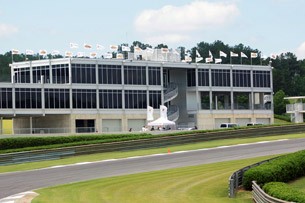
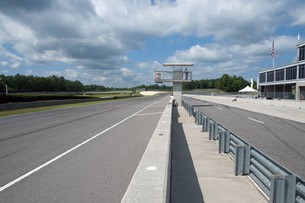
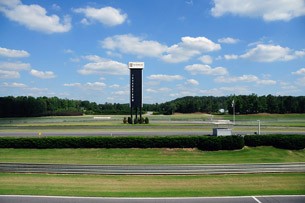
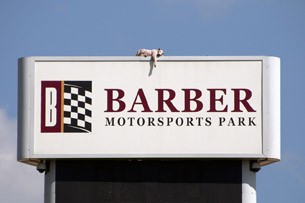
While that's hardly chump change, the cost includes track time with the 911 Turbo, GT3 street car and GT3 Cup race car – an immensely impressive trio with a combined worth of about half-a-million dollars. Each of those supercars cars is capable of hitting 60 mph in less than four seconds and topping out in excess of 190 mph.
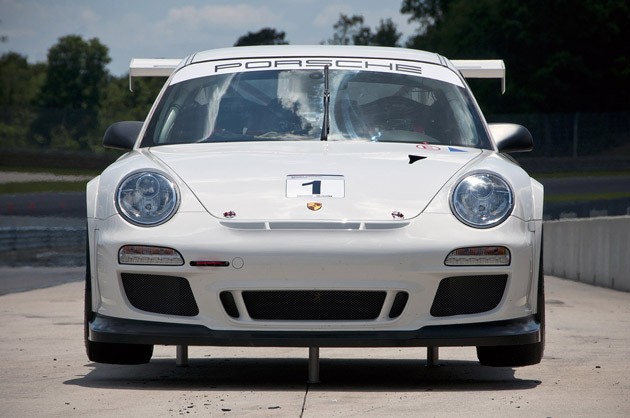
The day starts early. After meeting in the lobby just after sunrise we're shuttled in a procession of Panameras to the track about 40 minutes away. Brian Cunningham, a Porsche driving instructor who's been at the track since its inception, explains that the GT3 Cup Experience was designed to offer students a taller rung on the ladder – until now, those who had completed all of the school's standard courses had nowhere to go.
Continental breakfast at the track is the first event, followed by a chalk talk in the school's classroom. The conversation is very brief, as it only covers basics about the track itself and its unique corner light system. There is no talk about flag colors, turn-in points, how to apex or trail brake – if you're here, you're well beyond the basics. You know the players, you know the game and you know lifting mid-corner means your first born is out of a college education.
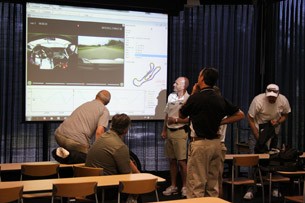
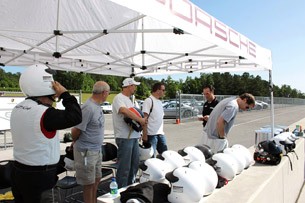
To provide a one-to-one instructor-to-student ratio, the GT3 Cup Experience class is deliberately small. We break into small groups for one of three track-driving exercises that will serve as our rotations throughout the day: 911 Turbo, GT3 street or GT3 Cup.
My first stint is in the stock GT3, a street-legal race-ready 911 variant with a 3.8-liter flat-six rated at 435 horsepower. With a curb weight of about 3,200 pounds, and six-speed manual transmission, it will run to 60 mph in about 3.8 seconds. Porsche has two GT3s on site – one has stock Michelin Sport Cup tires, a well-respected R-compound track tire, while the other is shod with Michelin Pilot PS2 street rubber.
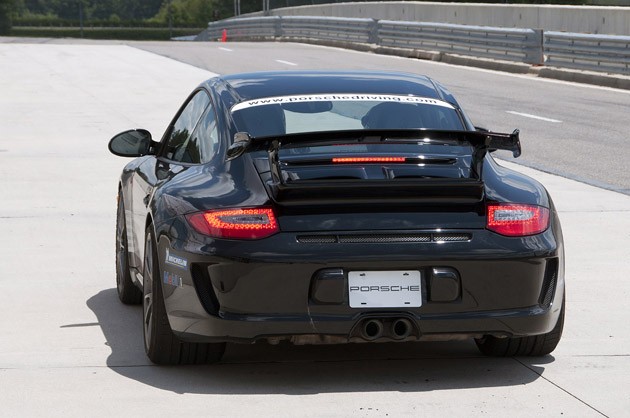
With an open-faced helmet strapped on my noggin and an instructor belted in the passenger seat, lapping the GT3 on the Barber circuit is pure bliss. Engineered and tuned specifically for the track, the rear-engine, rear-wheel-drive coupe dances lightly from corner to corner with near-perfect steering and gobs of braking capability. After a half-dozen hot laps, the PS2s start getting overheated requiring me to adjust my line. Get sloppy and the GT3's stability control will slap your wrists, but not until things have gone seriously downhill. A natural track star, the street-legal GT3 is unbelievably talented.
The Turbo is next on the list. Hanging out behind its rear wheels is a twin-turbocharged 3.6-liter rated at 500 horsepower. With a PDK transmission, and standard all-wheel drive, it will hit 60 mph in less than three seconds. While the Turbo has an insane amount of power, its curb weight of 3,516 pounds is a huge handicap. Thanks to its tenacious all-wheel drive, the blown 911 is the quickest out of the hole but slowest in the corners as it plows with varying degrees of understeer. It's obvious this is a GT, not a track star.
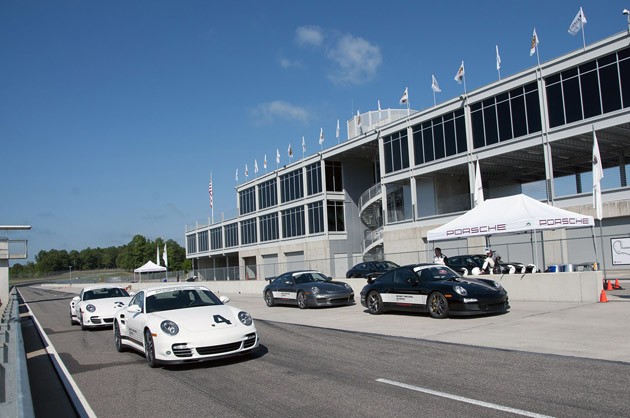
After stints in the street cars, it was time to be "fitted" for the GT3 Cup race car. The 45-minute exercise involves choosing a flame-resistant Nomex racing suit and a full-face helmet with an accompanying HANS (head and neck support) device to protect my head and spine. Before the helmet goes on, sound-deadening foam earplugs with miniature speakers are placed in each ear. A Nomex balaclava is recommended, while flame-resistant gloves and racing shoes are required. Once suited, I'm led over to the race car for more adjustments and some needed instruction.
Each corner of the GT3 Cup features height-adjustable suspension with dual coil springs and Sachs gas-pressure fixed-position dampers. The steering is handled by an electro-hydraulic rack-and-pinion design. Front brakes are six-piston fixed aluminum calipers over 15-inch drilled iron rotors, while the rear features four-piston fixed aluminum calipers over 14-inch drilled iron rotors. There are race-compound pads in the calipers, with ducting to keep the whole setup cool. Forged, center-bolt, three-piece BBS wheels (9.5x18 front and 12x18 rear) are wrapped in Michelin Porsche Cup N1 slicks (24/64-18 front and 27/68-18 rear). The curb weight of the finished GT3 Cup is just 2,646 pounds – an incredible 500 pounds lighter than the GT3 street version.
The cockpit of the GT3 Cup – like the engine room of an attack submarine – is all business. The creature-comforts of the GT3 street car are absent, leaving the steel panels of the monocoque coupe exposed. The dashboard has been sliced clean on each side. What remains makes room for the full welded safety cage and a few strategically placed fresh air vents. Primary instrumentation is a digital Motec ADL2 dashboard with integrated data recording and there's a carbon-fiber racing seat, thinly padded with flame-resistant upholstery, with the driver held in place by a six-point Schroth racing harness.
A quick-release three-spoke suede OMP steering wheel, with tilt-and-telescope function, features a push-to-talk button (the microphone is embedded in the driver's helmet), high beam, flasher and wiper switches plus a red button to silence alarms. All other controls, such as those for the main electrical, ignition and fire suppression are relegated to the center stack, which is nothing more than a flat black panel over the stock console. The brake bias dial is to the right of the steering wheel, while the start button is to the left – as it always is on a Porsche.
After being fitted to a seat, I undergo a thorough introduction to the cockpit switchgear and safety equipment while seated in the driving position. Once complete, it's time to take orientation laps from the passenger seat to experience what the GT3 Cup can do at the hands of a professional. It's a memorable ride, but pales in comparison to what is about to come.
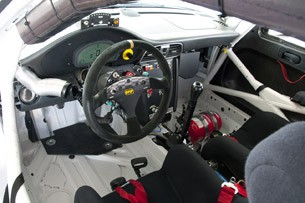
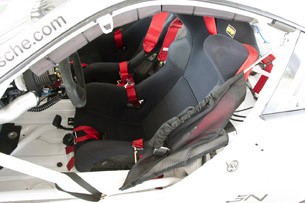
My turn to drive the GT3 Cup comes in the early afternoon. With the eagerness of a child heading to Disneyland, I bound over to the garage and suit back up. Parked in the hot pits, the racer is surrounded with a Porsche support crew who helps me wiggle over the cage and into the tight quarters of the bucket seat, cinching down the four belts and attaching my communication cable. It takes several long minutes for the team to triple-check tire pressures, reset data telemetry, do a radio test and clear the track. I become more nervous and overheated with each passing moment. The crew switches on an in-car fan, but I don't even feel a breeze. Bound firmly in place by those six nylon straps, my nose itches as big droplets of sweat drip off my brow. The GT3 Cup is stationary, but my mind is already racing.
I start the engine. "Let's go!"
The pit crew pushes on the back of the race car's fixed ducktail to break inertia. It is a futile effort, as my unfamiliarity causes me to release the clutch too quickly and promptly stall the engine. The second – this time successful – attempt involves much more power and I clear the paddock. Throttle response is touchy at crawling pit speeds, so the GT3 Cup bucks and shakes in protest. Once clear of the pits, I accelerate onto the track and any and all civility goes right out the rear Lexan window.
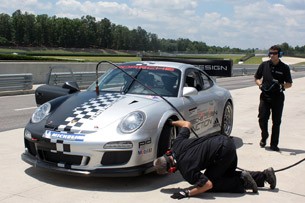
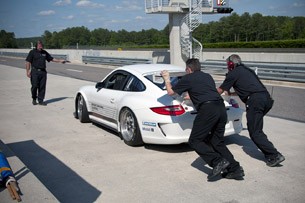
Mirroring the mannerisms of the GT3 street car, the GT3 Cup engine likes to spin quickly to its stratospheric 8,500 rpm redline. No sooner have I left the track entry when the glowing light on the top of the cluster tells me it is already time to shift. As instructed, the blindingly-fast "no-lift" shifts are accomplished by pulling back an inch on the tall gearbox lever. It's incredibly unnerving at first, but there's no need to lift off the throttle or depress the clutch. The race-bred sequential transmission prefers a very firm and deliberate hand. Treat it properly, and it rewards the driver with a solid kick to the pants as it engages.
I conservatively tip-toe around the circuit for the first few minutes, getting acquainted with the unworldly direct steering feel, sensitive throttle and rock-hard brake pedal. Strip out a vehicle's rubber bushings and sound insulation and it's stunning how much information is ascertained simply through seat-of-the-pants vibration and gearbox noise. There's no need to look at the speedometer or tachometer – you just feel... everything.
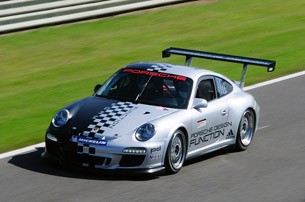
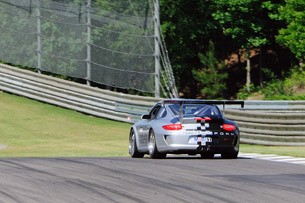
My speed and confidence pick up with each lap. I had decided early on that communication with the instructor in the passenger seat would be through hand signals (there's no way in Hell I was looking down for the tiny "push to talk" button on the wheel). I raise my right hand questionably, and Obi-Wan Kenobi's reassuring words of encouragement are piped through communication cables directly into my ears. Under these conditions, it is very soothing to have someone in the right seat offering guidance.
After 15 minutes of constant instruction, I am getting the hang of it. Unlike street cars driven on the track, which seem to get lighter and lighter the faster they go, the GT3 Cup gets remarkably more stable and planted the harder I push. Credit a ground-hugging stance, refined aerodynamics and that huge carbon-fiber wing slamming the gummy racing slicks down on the asphalt. Where the street-legal GT3 had me waiting for stability after a rise on the track, the GT3 Cup sticks firm and I shift resolutely at the top of a crest. Even the initially intimidating sequential gearbox with its deafening shrill becomes intuitive.
Trusting the grip, I begin to brake later and later and later into corners. The Cup car, like all four-wheel vehicles driven at the limit, gets squirrely quickly if asked to turn-in sharply while under hard deceleration. Too confident, I overcook a corner (or two) and completely unsettle the Porsche. More sweat is forced out of my forehead and down the bridge of my nose. This only serves as additional proof that I still have a lot of learning to do.
At best, I am running seven-tenths. My laps in the GT3 Cup are faster than they were in the GT3 and Turbo earlier in the day, but I can feel the untapped capability in the steering, brakes and grip. I'm not comfortable enough to rotate the chassis or brake at the threshold. I simply need more time to explore the limits of such a gifted machine.
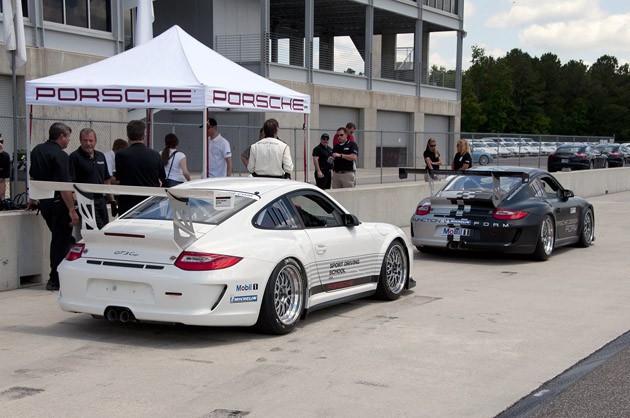
Thirty minutes later, at the end of my run, I grudgingly pull into the hot pits and point the nose towards a swarm of black-shirted pit crew. As they surround the vehicle I put the gearbox into Neutral and kill the ignition. The noise and vibration stop immediately. I'm instantly returned back to reality, but the adrenaline is still rushing.
Situated in the middle seat of a Continental 757-200 five hours after leaving the cockpit of a 911 GT3 Cup car, my body is still flooded with endorphins. I ignore my fellow flight passengers, who steal both of my armrests, and ponder the events over the past two days. While I've never parachuted, bungee-jumped or had an apple shot off my head with an arrow, I imagine each of those thrill-seeking undertakings pale when compared to the rush I felt behind the wheel of a proper Porsche race car. I've been tracking cars for more than a decade, but none of the experiences have ever been as exhilarating – or as educational – as piloting a podium-winning purebred on a professional racing circuit.
2011 Porsche 911 GT3 Cup - Click above for high-res image gallery
Beads of sweat itch as they drip down the bridge of my nose, but there is nothing I can do about it. My hands are buried deep inside fire-resistant racing gloves and my face is covered by a clear Lexan shield sealing the front of my full composite racing helmet. Waiting patiently for the signal from the pit crew, I shake my head side-to-side but the movement is thwarted by the nylon straps of the HANS device determined to keep my vertebrae stable. Eventually, the salty drops fall and they are absorbed by the Nomex balaclava resting against my chin.
Speakers in my foam earplugs crackle to life and a broken voice tells me it is time to start the engine. I had rehearsed this drill earlier in the day, so I use my right hand to switch on the master power. After a quick check to ensure the sequential gearbox is in Neutral, my other hand reaches to the left side of the carbon fiber dash and presses the start button. The engine fires to life and settles down to a coarse growl.
Several pit monkeys line up behind the vehicle, resting their hands on the rear wing, while the crew chief stands in front of the hood holding up a gloved palm. As the seconds tick by, I cinch my harness straps and scan the LCD instrument panel one more time. The voice in my ears cackles back with a simple, "Let's go."
I take a deep breath, put the Porsche 911 GT3 Cup car's gearbox into first gear and ease out the clutch...
The Porsche Sport Driving School was launched nearly two decades ago as the Porsche Driving Experience at Road Atlanta Raceway (and at Sebring). The school moved to its permanent home at the then-new Barber Motorsports Park in Birmingham, Alabama, in 2003. Today, the privately-owned facility boasts an impeccably-manicured 2.38-mile purpose-built road course with 16 turns and over 80 feet of elevation changes, not to mention being home to the Barber Vintage Museum's motorcycle collection – the largest in the world.
Headquartered at Barber, the factory-sponsored Porsche Sport Driving School offers everything from one-day beginner-level "Precision" classes ($1,795) to three-day "Masters Plus" programs ($5,295). Students of all talents learn in both classroom and on the track with skidpad and circuit exercises in a variety of Porsches including the Boxster, Cayman, 911 Carrera, and Cayenne. Instruction is led by Hurley Haywood, chief driving instructor, who headlines a very talented team of professional drivers including Jeff Purner, Cass Whitehead, James Gue, Daniel Eastman and Eric Huffman.




The GT3 Cup Experience costs a cool $10,000.
Touted by Porsche as the "most advanced manufacturer driving curriculum available in North America," the "GT3 Cup Experience" is an all-new pinnacle program that the school has just launched. While open to the general public, registrations are (understandably) only accepted from those who have worked their way up the prerequisite ladder (completed the three-day Masters Plus, Masters, Performance and Precision programs). The school will also recognize an SCCA Regional, National Competition Racing license or equivalent to meet the minimum requirements and the price for the inclusive two-day GT3 Cup Experience rings in at a cool $10,000.
While that's hardly chump change, the cost includes track time with the 911 Turbo, GT3 street car and GT3 Cup race car – an immensely impressive trio with a combined worth of about half-a-million dollars. Each of those supercars cars is capable of hitting 60 mph in less than four seconds and topping out in excess of 190 mph.

The day starts early. After meeting in the lobby just after sunrise we're shuttled in a procession of Panameras to the track about 40 minutes away. Brian Cunningham, a Porsche driving instructor who's been at the track since its inception, explains that the GT3 Cup Experience was designed to offer students a taller rung on the ladder – until now, those who had completed all of the school's standard courses had nowhere to go.
There's no talk about flag colors, turn-in points, how to apex or trail brake – If you're here, you're well beyond the basics.
Porsche sells a surprising number of its race-ready 911 GT3 Cup cars to private individuals who race them competitively. This new program allows owners, both prospective and current, to become qualified and comfortable with the vehicle before venturing out on their own. Of course, it also satisfies the dreams of those who rock themselves to sleep at night with thoughts of shifting Porsche's sequential six-speed dog-leg gearbox at a screaming 8,500 rpm while flying down the main straight.
Continental breakfast at the track is the first event, followed by a chalk talk in the school's classroom. The conversation is very brief, as it only covers basics about the track itself and its unique corner light system. There is no talk about flag colors, turn-in points, how to apex or trail brake – if you're here, you're well beyond the basics. You know the players, you know the game and you know lifting mid-corner means your first born is out of a college education.


To provide a one-to-one instructor-to-student ratio, the GT3 Cup Experience class is deliberately small. We break into small groups for one of three track-driving exercises that will serve as our rotations throughout the day: 911 Turbo, GT3 street or GT3 Cup.
My first stint is in the stock GT3, a street-legal race-ready 911 variant with a 3.8-liter flat-six rated at 435 horsepower. With a curb weight of about 3,200 pounds, and six-speed manual transmission, it will run to 60 mph in about 3.8 seconds. Porsche has two GT3s on site – one has stock Michelin Sport Cup tires, a well-respected R-compound track tire, while the other is shod with Michelin Pilot PS2 street rubber.

With an open-faced helmet strapped on my noggin and an instructor belted in the passenger seat, lapping the GT3 on the Barber circuit is pure bliss. Engineered and tuned specifically for the track, the rear-engine, rear-wheel-drive coupe dances lightly from corner to corner with near-perfect steering and gobs of braking capability. After a half-dozen hot laps, the PS2s start getting overheated requiring me to adjust my line. Get sloppy and the GT3's stability control will slap your wrists, but not until things have gone seriously downhill. A natural track star, the street-legal GT3 is unbelievably talented.
The Turbo is next on the list. Hanging out behind its rear wheels is a twin-turbocharged 3.6-liter rated at 500 horsepower. With a PDK transmission, and standard all-wheel drive, it will hit 60 mph in less than three seconds. While the Turbo has an insane amount of power, its curb weight of 3,516 pounds is a huge handicap. Thanks to its tenacious all-wheel drive, the blown 911 is the quickest out of the hole but slowest in the corners as it plows with varying degrees of understeer. It's obvious this is a GT, not a track star.

After stints in the street cars, it was time to be "fitted" for the GT3 Cup race car. The 45-minute exercise involves choosing a flame-resistant Nomex racing suit and a full-face helmet with an accompanying HANS (head and neck support) device to protect my head and spine. Before the helmet goes on, sound-deadening foam earplugs with miniature speakers are placed in each ear. A Nomex balaclava is recommended, while flame-resistant gloves and racing shoes are required. Once suited, I'm led over to the race car for more adjustments and some needed instruction.
The curb weight of the finished GT3 Cup is just 2,646 pounds – an incredible 500 pounds lighter than the GT3 street version.
The 2011 Porsche GT3 Cup race car, the current iteration of the most successful race car ever produced, is both wider and more powerful than last year's model. Like all variants of GT3, it starts production on the same Stuttgart, Germany assembly line as the standard 911 Carrera. However, while the street versions are fitted with upholstery, sound deadening and Bluetooth phone connectivity, the future race car leaves the factory as a features-stunted bare chassis. In another facility, the body-in-white GT3 Cup receives a naturally-aspirated 3.8-liter flat-six with dry sump lubrication. Rated at 450 horsepower, the engine is bolted to a sequential six-speed dog-type gearbox (a dog box is more durable, and has less transmission losses compared to a helical gearbox) with a racing clutch. A mechanically-locking rear axle differential completes the driveline.
Each corner of the GT3 Cup features height-adjustable suspension with dual coil springs and Sachs gas-pressure fixed-position dampers. The steering is handled by an electro-hydraulic rack-and-pinion design. Front brakes are six-piston fixed aluminum calipers over 15-inch drilled iron rotors, while the rear features four-piston fixed aluminum calipers over 14-inch drilled iron rotors. There are race-compound pads in the calipers, with ducting to keep the whole setup cool. Forged, center-bolt, three-piece BBS wheels (9.5x18 front and 12x18 rear) are wrapped in Michelin Porsche Cup N1 slicks (24/64-18 front and 27/68-18 rear). The curb weight of the finished GT3 Cup is just 2,646 pounds – an incredible 500 pounds lighter than the GT3 street version.
The cockpit of the GT3 Cup – like the engine room of an attack submarine – is all business. The creature-comforts of the GT3 street car are absent, leaving the steel panels of the monocoque coupe exposed. The dashboard has been sliced clean on each side. What remains makes room for the full welded safety cage and a few strategically placed fresh air vents. Primary instrumentation is a digital Motec ADL2 dashboard with integrated data recording and there's a carbon-fiber racing seat, thinly padded with flame-resistant upholstery, with the driver held in place by a six-point Schroth racing harness.
A quick-release three-spoke suede OMP steering wheel, with tilt-and-telescope function, features a push-to-talk button (the microphone is embedded in the driver's helmet), high beam, flasher and wiper switches plus a red button to silence alarms. All other controls, such as those for the main electrical, ignition and fire suppression are relegated to the center stack, which is nothing more than a flat black panel over the stock console. The brake bias dial is to the right of the steering wheel, while the start button is to the left – as it always is on a Porsche.
After being fitted to a seat, I undergo a thorough introduction to the cockpit switchgear and safety equipment while seated in the driving position. Once complete, it's time to take orientation laps from the passenger seat to experience what the GT3 Cup can do at the hands of a professional. It's a memorable ride, but pales in comparison to what is about to come.


My turn to drive the GT3 Cup comes in the early afternoon. With the eagerness of a child heading to Disneyland, I bound over to the garage and suit back up. Parked in the hot pits, the racer is surrounded with a Porsche support crew who helps me wiggle over the cage and into the tight quarters of the bucket seat, cinching down the four belts and attaching my communication cable. It takes several long minutes for the team to triple-check tire pressures, reset data telemetry, do a radio test and clear the track. I become more nervous and overheated with each passing moment. The crew switches on an in-car fan, but I don't even feel a breeze. Bound firmly in place by those six nylon straps, my nose itches as big droplets of sweat drip off my brow. The GT3 Cup is stationary, but my mind is already racing.
I start the engine. "Let's go!"
The pit crew pushes on the back of the race car's fixed ducktail to break inertia. It is a futile effort, as my unfamiliarity causes me to release the clutch too quickly and promptly stall the engine. The second – this time successful – attempt involves much more power and I clear the paddock. Throttle response is touchy at crawling pit speeds, so the GT3 Cup bucks and shakes in protest. Once clear of the pits, I accelerate onto the track and any and all civility goes right out the rear Lexan window.


Mirroring the mannerisms of the GT3 street car, the GT3 Cup engine likes to spin quickly to its stratospheric 8,500 rpm redline. No sooner have I left the track entry when the glowing light on the top of the cluster tells me it is already time to shift. As instructed, the blindingly-fast "no-lift" shifts are accomplished by pulling back an inch on the tall gearbox lever. It's incredibly unnerving at first, but there's no need to lift off the throttle or depress the clutch. The race-bred sequential transmission prefers a very firm and deliberate hand. Treat it properly, and it rewards the driver with a solid kick to the pants as it engages.
There's no need to look at the speedometer or tachometer – you just feel... everything.
Downshifts are a bit trickier, but every bit as fast. The clutch goes in (simply for longevity, not out of necessity), which signals the ECU to automatically blip the throttle. The shift lever is simultaneously shoved forward an inch. The accompanying sound is horrifyingly mechanical, like something wallet-lightening is happening in the 'box, but the process is perfectly normal and blazing at speed.
I conservatively tip-toe around the circuit for the first few minutes, getting acquainted with the unworldly direct steering feel, sensitive throttle and rock-hard brake pedal. Strip out a vehicle's rubber bushings and sound insulation and it's stunning how much information is ascertained simply through seat-of-the-pants vibration and gearbox noise. There's no need to look at the speedometer or tachometer – you just feel... everything.


My speed and confidence pick up with each lap. I had decided early on that communication with the instructor in the passenger seat would be through hand signals (there's no way in Hell I was looking down for the tiny "push to talk" button on the wheel). I raise my right hand questionably, and Obi-Wan Kenobi's reassuring words of encouragement are piped through communication cables directly into my ears. Under these conditions, it is very soothing to have someone in the right seat offering guidance.
After 15 minutes of constant instruction, I am getting the hang of it. Unlike street cars driven on the track, which seem to get lighter and lighter the faster they go, the GT3 Cup gets remarkably more stable and planted the harder I push. Credit a ground-hugging stance, refined aerodynamics and that huge carbon-fiber wing slamming the gummy racing slicks down on the asphalt. Where the street-legal GT3 had me waiting for stability after a rise on the track, the GT3 Cup sticks firm and I shift resolutely at the top of a crest. Even the initially intimidating sequential gearbox with its deafening shrill becomes intuitive.
Trusting the grip, I begin to brake later and later and later into corners. The Cup car, like all four-wheel vehicles driven at the limit, gets squirrely quickly if asked to turn-in sharply while under hard deceleration. Too confident, I overcook a corner (or two) and completely unsettle the Porsche. More sweat is forced out of my forehead and down the bridge of my nose. This only serves as additional proof that I still have a lot of learning to do.
At best, I am running seven-tenths. My laps in the GT3 Cup are faster than they were in the GT3 and Turbo earlier in the day, but I can feel the untapped capability in the steering, brakes and grip. I'm not comfortable enough to rotate the chassis or brake at the threshold. I simply need more time to explore the limits of such a gifted machine.

Thirty minutes later, at the end of my run, I grudgingly pull into the hot pits and point the nose towards a swarm of black-shirted pit crew. As they surround the vehicle I put the gearbox into Neutral and kill the ignition. The noise and vibration stop immediately. I'm instantly returned back to reality, but the adrenaline is still rushing.
Situated in the middle seat of a Continental 757-200 five hours after leaving the cockpit of a 911 GT3 Cup car, my body is still flooded with endorphins. I ignore my fellow flight passengers, who steal both of my armrests, and ponder the events over the past two days. While I've never parachuted, bungee-jumped or had an apple shot off my head with an arrow, I imagine each of those thrill-seeking undertakings pale when compared to the rush I felt behind the wheel of a proper Porsche race car. I've been tracking cars for more than a decade, but none of the experiences have ever been as exhilarating – or as educational – as piloting a podium-winning purebred on a professional racing circuit.


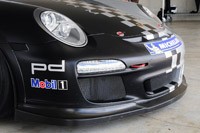
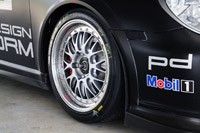
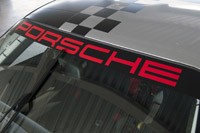









Sign in to post
Please sign in to leave a comment.
Continue